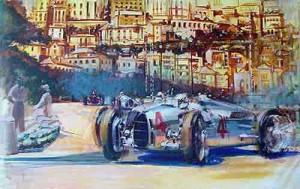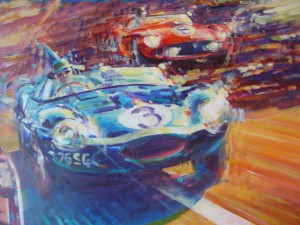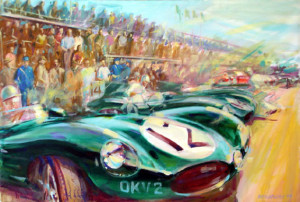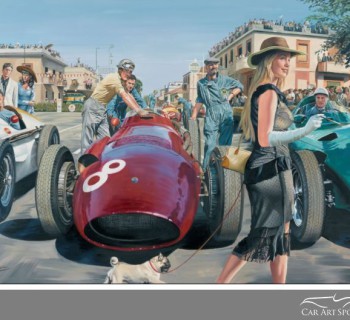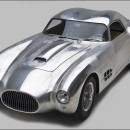Andrew McGeachy does full time art and design projects and is now experimenting with sculpting. Most of his work is commissioned. He likes to bring across an emotional feeling and reflect the kind of passion which went into producing his artwork and would perhaps like to put more humour into it too.
I read on your website that you have this unique education combining technique with art. How did that happen?
As a small kid I was always interested in drawing and cars. So you put those together and you become a car designer. That's very simplified but that's kind of it. I was like many kids, sketching cars in my exercise books but also doing school work as well. In the mid 70's, I had a friend who I would always draw and design cars together with. He was one of those friends from the past that you wonder today what became of him.
Was it an intentional choice to do those two separate educations?
The thing is, my Dad didn't understand what car design was about. He knew what architecture was and so he tried to push me in that direction. I resisted and paradoxically, I am actually much more interested in architecture now than I was then. So I had to find my Dad a bit, persevere and finally I studied Industrial Design at Coventry Polytechnic, which has become quite a well known school for automotive design these days. At the time it was less focused on automotive design. It was industrial design transportation in brackets. They used to say that transportation is anything that moves. So it could be anything, a coach, a train, a motorcycle or a car but these days it has become much more focused on automotive design.
But did it also have all the technical aspects of mechanical engineering etc?
Yes it wasn't just specifically about styling. That's the sort of designer I am. I like to think more about things than just skin deep and I am still interested in taking things apart and putting them back together. So yes, I would say there is a technical interest as well. I've always been interested in cars from an engineering side, as just purely aesthetic. When I used to draw with my friend, we used to draw engines and weber carburettor trumpets were very much in evidence. Sometimes, trying to design engines which may work or may not have worked.
One of your illustrative designs is the Cayenne and the Audi wheel which is a combination of design and technical drawing. So you can do both?
Yes I can do both. Those were for a tuner in Zurich who are mainly concerned with Porsche and Audi and then we did for them the most elaborate project in terms of bodywork so far.
So you started with an engineering education at the Polytechnic?
Well industrial design is a kind of marriage between technical and aesthetic and then when you go into car design it tends to verge more on styling. So more purely aesthetic. But there are different types of designers. There are some who are very good with shapes but less good with actually imagining how you would produce such a thing. Then there are other guys who are technical engineering beasts and maybe less good with sculptural forms. I would place myself somewhere in between. I think sometimes if you can imagine how something is made and perhaps in a different way to the norm, you may come up with something really interesting. So quite often when I look at a design project, I am considering how it might be made and how that may influence the aesthetic. I then try to come up with something more original.
After your Polytechnic education, you moved to the Royal College of Art? That must have been quite a culture shock, wasn't it?
Well it wasn't purely engineering. Maybe it's the word polytechnic which sounds as if it's purely engineer based discipline but that's not necessarily true. The Royal College of Art has of course the fine arts culture and textile design but they also have architecture and automotive design, and also product design. But it's funny because the fine artists probably view us as engineers because it's another end of the spectrum. On the other hand, the guys doing the more technically biased disciplines are more likely to find employment in the end. I very much believe it doesn't matter what the school is teaching, the upper 5% are always going to be good and will always find a place. It doesn't matter what we are talking about. That tends to be the feeling at the RCA. There's all these guys doing conceptual stuff and then there's us, who tend to find jobs.
I don't know if this had an influence on me. There are theories about some events or situations that occur in early life which can influence you, even if you don't remember them.
So there is a story. I was born in Glasgow and I lived there until I was five and then my parents moved to England. One day my Mum went shopping and took me in my pram. She left me outside a shop and when she came back out, she forgot about me and went home. She had this idea that my sister had taken me home. So when she got home and found out that she had left me behind, she panicked and thought that I would be totally traumatised bawling my head off. She rushed back and there I was happily watching the cars. I have no recollection of that myself but maybe this was the start of some fascination with cars. You just don't know; there are sometimes profound things which have an effect on you without you knowing.
What is your daily occupation now Andrew? Is it full time artwork or freelance design work?
It's both but it depends on the project. In general, my design projects have tighter deadlines, so they tend to take precedence over artwork. Unless it's a commercial commission, which also has a deadline. In general that's how it is but it can change from one week to another. Sometimes I do more artwork than design work and vice versa. It depends what comes.
What inspires you to start creating artwork?
Often it's just an idea of a car I really like. It may be an article in a current magazine or a photograph from the 1920's which strikes me as a strong image which I take as a basis. Or I might put a car in a different context.
What determines the context? I notice in quite a few of your artworks that you combine the old with the new.
Yes that's true. Not always but perhaps it's to retrace the heritage of a particular brand or perhaps it's to identify certain values of a brand which have been consistent. Meaning what was a particular trait of the brand some years ago is still current, or has a similar importance. Or I might just stumble on a photo of a landscape with particular colours and I just think it would make a really nice backdrop with a car in it. Often if it's an historical image, of course it's black and white. Some people find it surprising that I can take a black and white photo as a basis and then put some vehicles in. Or I change the perspective quite often to make it more dynamic or change the scale of certain elements in the composition. This adds depth and makes it more dynamic. If it's a single car in race, I may add a second or third vehicle to add more of a competition feeling. Some people find this almost magical and are surprised that I can manage to translate this into colour. But if it's an Alpha Romeo, you know it's red. To me it's natural. I don't see any complications there.
Your style is impressionistic. How did you develop it?
When I was younger, back in the days when I was drawing cars with my friend on his living room floor, we had sharp pencils and were trying to do very precise illustrations. But after a while I really wanted to do something more emotive, emotional and dynamic. I started seeing work from guys like Dexter Brown and Michael Turner, whose work was a bit less of an influence because he tends to be much more precise as well. Then you have all these guys who are trying to be perfectionists but sometimes the result is, I find, rather dead. All the details are perfect and if it's a racing scene, all the advertising banners, colours and graphics around the circuit are all just right. But there are so many people doing this and some do it very well, and some do it less well but I thought I would rather be doing something a bit different with more emotion. So I started messing around with more dynamic images and I developed this style. I started using acrylic paint and that's how it began really. The fact that I used to draw very precisely (and sometimes I still have to), was a very good training because it forces you to really look and explain to yourself what you are looking at and what you are trying to achieve on paper or canvas. This develops a certain eye training, so you look at something and you understand what it is you are looking at. What I find now is that I can indicate this in a much more spontaneous and natural way. The danger is that if you try to do things really precisely, it becomes overworked. The other aspect is, there are quite a few Japanese guys using airbrush. Some of it is brilliant but I look at it sometimes and ask myself why the guy didn't just buy a camera. You have to admire the technique and for me, in all paintings and drawings, technique is really important because there is so much crap around. They are trying to cover up because they can't actually draw or paint. But some of these guys get away with it and some are quite successful. For me, it doesn't matter what the subject it is, you need a technique. If you haven't got that, you should be doing something else. That's my opinion.
You have to admire some of the Japanese airbrush guys' technique. It's just incredible. But first of all you have to do an extremely precise layout before you start. They mask everything, then they get the airbrush and mix up the ink and spray for 35 seconds or maybe less. Then they stop, take the airbrush apart, clean it, then take the masking off, re-mask and the process starts again. This would drive me mad. It's not me. I often paint live and when I go to a classic car show, I stand there with some examples of my work and generally do a painting for a few reasons. It sometimes gets a bit boring. There are always waits, so it's nice to be occupied and also it animates. Some people are quite astounded. I start with a canvas with mainly nothing on it and I just start painting. Whereas a lot of guys will actually draw the whole composition precisely but then it becomes like painting with numbers. I prefer things to be much livelier. I have an idea and very often I do some sketches before, especially if there is a commission because then I can show it to the customer. He then has a better idea of what he is going to get and it's also a discussion point. The painting has a certain personal feel because it's not just a painting of a car, it becomes a personal aspect.
Is it more difficult with commissioned work than if you just create your own topic?
I find it very often takes longer. I don't know if it's because I am really conscious that I want the customer to be happy. In general the process isn't very complicated, although in some cases it has been, and those are the ones where the results are not necessarily so good. I find the more people mess around, the worse it gets. One example; a guy changed his mind half way through and then he wanted more on the painting. In the end I wasn't happy. I find it's better if there is more freedom. If it's really not what the customer had in mind, then we can discuss it and I may perhaps do another. I quickly do a sketch, use it for a basis, and work out a composition and the colour elements. Then I do a painting which may be quite big but when I paint live, people see how fast I am. There's always the classic question of how long paintings takes me to do. Now I tell people that they take 48 years and they look at me strangely. But it's not completely a joke because I've been drawing all that time. Some of the best paintings I do are actually completed pretty fast; two or three hours and it's done. Every time I start painting, I hope it's the best one I've ever done but it doesn't work that way. Sometimes I start and it just flows and I put something in quickly but rework it later to make it more precise. I think it looks okay and leave it. Then other times I start and the perspective is bad and the colours are not right and everything is just muddy. Then you think it's probably better to stop. This is of course worse when you are doing it live and to be honest, I think a lot of guys wouldn't even dare to do this. I know a lot of guys doing automotive art who don't actually draw, they project. All those guys would never paint live because they can't. I draw the perspective on the canvas totally freehand and there's just a few marks, or sometimes none and I just paint. Sometimes I take a colour pencil and put the basic structure down but there is little work because I let the paint dominate and take over. I give it a bit of freedom and things happen sometimes accidentally and hopefully in a good way. And that's what I am like because it keeps it alive.
Steve McQueen by Andrew McGeachy
Do you sometimes throw it away at the end of the day?
Sometimes I do a painting, finish and leave my studio (which is next to my house). Then I come in the following morning and think 'how could I have been satisfied with that?'. It's funny because you see it with fresh eyes or it can be a few weeks later and you see things which are wrong.
I may retouch it and in a few minutes it's totally transformed. Other times, I just paint over it.
I noticed you did a few different types of Mille Miglia mixed media wall sculptures.
Well the Mille Miglia was of course a very important race. Also in terms of developments of the design of some cars. There was a lot of research on coupes because they were more comfortable and more aero dynamic. If you are going to be driving that long it starts to become an issue. So from a design aspect, the Mille Miglia was quite an influential race. Even for motoring cars. If you look at the 1940 BMW Mille Miglia touring car; this was the pinnacle of pre-war full width body work thinking. So I did open cars and coupes and there are a series of sheets of aluminium, silhouettes and acrylic sheets for the red arrow. But I've also been experimenting with some other sculptures which are bigger and multi-media things. There are two on the website. One is called Clash of Teutonic Titans. The background is flat, then the car has volume, so it's about 1.50 meters long and about 27 meters deep. I am experimenting with those. The first was a Grand Prix Maserati with two mechanics working on it. It's a combination of paper maché and pieces of metal, bicycle brake cables for the hydraulic brake lines. Then I thought it might be nice to combine the dynamic feeling of the painting with 2.5D, not completely 3D because they remain raw pieces.
So you start with the paper maché and then you shape it. Is it more like sculpting?
It is but it's fun to do because I get to use all my junk. I like messing around with old cars and bikes and old junk.
Is this a technique which you plan to develop further?
Well why not? I haven't done one for a couple of years but it's something I would like to look at again.
How is that being received by the audience?
I think people like it. People say they have never seen anything like it before. There was a guy called Beckett who did this. He often used to have a booth in Paris and he was doing a lot of mural sculptures. He gave me an inspirational idea. The way I do it is very different though.
Do you have a dream or a bucket list of artwork you want to make one day?
I might experiment a bit more with some of these sculptural ideas with aircraft. I am quite a fan of propeller aircraft. In terms of automotive, I think there are two things I would like to try to explore a bit more but I am not sure it would work. One is to inject more humour. I like to joke. A lot of my artwork doesn't necessarily express that. I think a lot of people get too serious about cars. Of course there are many seductive aspects of cars which is why I paint them. But I like to try and bring across an emotional feeling; the fact that all the cars I paint are handmade and I want to try to reflect that kind of passion which went into producing them. Trying to get that feeling on the canvas and also the feeling that they are dynamic. I do illustrations and some are design influenced but I like to get this feeling of speed. Some people look at my paintings and say that you can almost hear it.
But you would like to put some humour into it.
I have to decide how to do that. What I really like is to inject humour but retain all the better aspects of my work, like the accuracy. For instance, if you are not successful in capturing the character of the car, it doesn't work.
A lot of automotive artists are struggling with positioning their art and are stuck in a niche. They would like to be considered as regular artists who happen to have cars as a topic. Do you have the same experience?
I do paint other things. I live in the country and have very nice views, so I don't need to leave the house to paint. Or I can walk up the road to the nature reserve.
One problem with automotive art is that real art lovers maybe don't view it as art because of the subject matter. It's not seen as a valid subject or it's not a typical art lovers subject. So that's one potential problem. Although having said that, because I like to create a complete atmosphere and ambiance in my paintings, they can appeal to non car people. I think another problem is a lot of car collectors don't want to spend money. They are happy to spend all their money on their cars but they don't necessarily want to spend money on art. I have a lot of positive comments but people talk a lot and doing the deal is something else.
Is it not risky adding more humour to your art? I would be very interested to see how adding more humour in your art pans out Andrew.
Yes I think it is risky. The other danger is, not to let it become some kind of a parody.
My wife is always telling me that I should do something more outrageous with my artwork. A bit more off the wall. I think she is right. The problem is, if things are too classic, people don't see it as contemporary.
I think it's the ongoing dilemma which a lot of artists have. They know that if they go out of the safe area, there may be less of an audience, which means less income. But on the contrary, you also see the artists who have done it and have become unique with a much stronger style.
If I were to pursue this, the style of painting wouldn't necessarily change. It would be more of introducing elements. Perhaps poking fun at all car movements to some degree but then the danger is, it could be taken offensively by some people. This is something I would like to consider but I have to think about how to do this. It's not really a fear of how it would be received, it's just doing something which I would be satisfied with. To get the right balance between humour without detracting from the quality of my work.
It would be closer to who you are yourself as a person Andrew. But it's a search.
I think because I have developed a dynamic impressionistic style, this reflects a certain way I feel about cars, the way I look at them and the sort of effect they have on me. Meaning, I am trying to reflect the sort of passion which goes into designing these cars. Like driving along the pacific coast line with some good friends, complete feeling of freedom with no care in the world......... that sort of thing. If someone says to me, if you had unlimited money, what car would you buy, I think the most enthusiasts would have a list but on that list there are not many modern cars. If I had to buy a more modern car, it's not easy to make a choice. But unfortunately, the cars that I feel much more warmth to are not being made today. From every decade there have been beautiful cars, a lot has to do with the proportion and how certain elements have been harmonized and then we are talking about the development of enclosed or full width body work etc. To say what is a real beauty, the list isn't very long.
There are all these things which I feel absolutely nothing about. They are just appliances. On the other hand, the car as an object and how it fits in society has changed. My wife is a teacher in a secondary school. The most of them are just not into cars. They are into Nike trainers.
I would not be surprised if in 10, 20 years time from now, we are looking back at cars as a period in time and our transport will be different. By that time the role of the current automotive artist will be more important because they will have been capturing the emotion and feeling that came with the cars. Also that emotion will be gone in 20 or 30 years time.
One would hope not but there is that risk. It's a paradox because on one hand we have all the political pressures against cars and then we have a lot of new aspects.
In my opinion, it emphasizes the important role of todays' automotive artists. I think the art world will recognize this in a couple of years as being something they have missed.
If you look at other transport subjects, you have marine art and aviation. Marine art has a non-history but seems more respected than automotive art, historically speaking.
One aspect of any form of art is the connection. So many aspects have nothing to do with the quality of the work and this I find a huge frustration. But that's how it is. It's true in other aspects of business and it always will be.
It's about how you are being promoted. Position art within the regular art world and convince art collectors that automotive art should be part of their collection.
Years ago I would just draw a car on the paper but these days it's the whole image, the whole context which interests me more. It's like you can imagine a story just looking at the image. Wondering where these people are going, what are they going to do and this I find much more interesting than just a portrait of a vehicle.
The term artist. Some people are labelling themselves that. It's a blurry definition. One description of a piece of art is something which has no function. Well you can hang this thing on the wall.
Art beautifies our Lives. The problem I have is that an awful lot does not beautify.
I find there is a lot of ugliness in Modern Art and lacking in finesse which to me does nothing. I try to create what I think are beautiful images. This is what I hope but it doesn't always happen.
To see more, please go to Andrew McGeachy website






